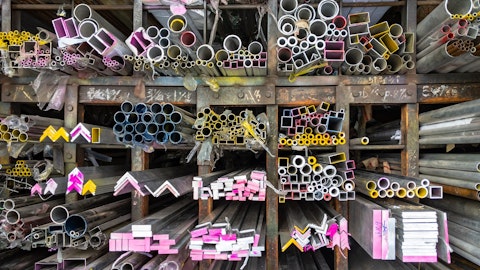Vince Morales: Yes, Josh, let me start, and I’ll let Tim add some color here. But we did — I just want to remind people — and again, we talked about this in opening comments in our prepared remarks we released last evening. Just a reminder, Q1 last year in Europe, there was exceedingly high. Energy costs, natural gas costs were $30 to $40 per MMBtu depending on the day. Most companies, PPG included invoked surcharges to pass those through that. We’re lapping that in Q1 of this year. That is a third to half of our price decline in the first quarter in the Industrial Coatings segment. And the remainder is organic based on the indices that Tim was talking about. Tim you have some color here?
TimKnavish: Yes, I think the question about margin expansion beyond what Vince described in pricing is the volume leverage will be significant on the industrial segment because that’s the segment that really got hit the hardest during COVID and COVID recovery and so we’ve still got significant margin upside driven by volume leverage. The other side, if you go back to our CEO Day in May in New York, we pointed to about $150 million to $200 million of manufacturing productivity gains that we had line of sight to in the coming years, really, not just to get back to where we were pre-COVID, but also as we modernize, automate, digitize our operations. So those will really be the two levers that get us to the next horizon on margin largely across the industrial segment, but somewhat also in the Performance Coatings side.
Operator: Our next question comes from Kevin McCarthy with VRP. Your line is open. Please go ahead.
Kevin McCarthy: Thanks and good morning, everyone. Tim, would you elaborate on your volume outlook that’s embedded in your 2024 guide? Would you expect volumes to be flat or up a little bit? Part of the reason I ask is we’ve seen many chemical companies suffer from volumes that are trending well-below real GDP. And so as you look across your portfolio and survey and forecast, do you think we’ll see convergence in 2024? Or are there pockets of residual destocking or other headwinds that might make that more ambitious?
TimKnavish: Yes. Hi, Kevin. So first of all, we’re going to have positive volume in 2024 for the year. I would – our sales, we said, are going to be up low single digits, we might have to start putting a fourth letter there because I think the – I’m sorry, the volume will be a little higher on the low single-digit side and the price will be a little lower on the low single-digit side. But we have volume momentum for really five quarters now, minus three, minus two, a little lighter, minus two, our fourth quarter. We rounded it up to minus one. It was actually less than minus one. We’re looking at a zero for Q1. And that includes the impact of the Walmart load in. It includes the shift from of Easter from one quarter to the next.
So we have momentum on volume, some of it just because of the diversity of our portfolio and where we participate, but some of it because of the growth initiatives that we’ve worked on throughout 2023, where we’ve picked up share that will start to kick in this year. I think about our packaging coatings business, our Industrial Coatings business, our refinish coatings business. So it’s really the positivity on volume is one even though they’ve had negative numbers in front of them for much of 2023, we do have volume momentum. We see it flipping in early 2024. And it’s a combination of strength of our portfolio positioning and execution on our growth initiatives.
Vince Morales: And just a couple of other items of note, Kevin, we expect Europe to stabilize, which really reflects a lack of a destock. We experienced a destocking, especially in the first half of 2023, and that’s — we feel that’s won its course. So stabilization in Europe, which has been a negative for us. And again, China on the 2023, first half basis was light. So again, as that normalizes the pandemic effect of that hopefully is behind us. And as that normalizes, provides us with some uplift. And we are — we do have this backlog that Tim alluded to in the opening remarks in aerospace. So we continue to produce more products at our manufacturing sites and that we expect that to continue to grow throughout the year to work down that backlog, which is more than a half a year backlog for us.
Operator: Our next question comes from Michael Leithead with Barclays. Your line is open. Please go ahead.
Michael Leithead: Great. Thanks. Good morning, guys. I wanted to ask around cash deployment. Your net leverage ended the year towards the lower end of where it’s historically been. I guess, three very brief questions. One, can you just remind us roughly what target leverage you intend to maintain? Two, how does the M&A market look today, say, relative to returning more cash to shareholders this year? And then third, I think you’re guiding to $15 million of interest in 1Q, but about $95 million for the year. So why does that step up so much? I’m assuming that takes into consideration of more cash deployment. Could you just help clarify that? Thank you.
TimKnavish: Yes. Hi. Mike, it’s Tim. I’ll start. Target, we don’t write a target in pen because it changes with time, depending on where we are in the execution of our strategy. We’re doing some portfolio things. You’ve seen some announcements in that regard. And where we are on our strength of our balance sheet, very strong right now, but it would be different as the environment changes. M&A, it has — it was a little quiet there for some time. We’re seeing some things come across our desk now. Nothing huge in the pipeline, but we’re seeing some assets come across, and we’re evaluating those. Overall, on the strength of the balance sheet and deployment, consistent with what I said throughout last year, number one, we’re going to focus on continuing to generate strong cash.
That gives us a great deal of flexibility. I’m very proud of what the team did in 2023. Just to be very clear, we will not let cash sit on the balance sheet. We’ll do what we need to do from dividends. We’ve got some good organic growth investments that we’ll invest in. Love to do some shareholder value accretion — accretive acquisitions. And if that doesn’t come along, then we’ll return cash by buying shares. We did some in Q4 for the first time in a long time. And if we’ve got excess cash sitting on the balance sheet, you can be assured that that’s what we’ll do. Now Q1, we’re sitting with a lot of cash right now, but we typically consume significant cash in Q1. And so we’ll be a little cautious here in Q1 so that we don’t get back into paying high interest cost debt, which we just got out of.
But beyond that, you should expect us to not let the cash sit there.
Vince Morales: Yes. Let me just add. This is Vince. I just want to reemphasize the key comment Tim said, we prefer a strong balance sheet. Due to the optionality, it gives us on many fronts. We feel where we are today. We don’t need to let cash grow. We will consume cash through April. That’s our traditional seasonality of our businesses. So the $1.5 billion that sits on the balance sheet, we will consume them through April. That allows us to not enter the debt markets as significantly as we normally would for commercial paper. At this time of the year, we’re typically adding commercial paper throughout — from now through the end of April. So that’s why our interest cost in Q1 will be lower, because we’re going to use the cash on hand to fund that seasonal inventory build.
That cash will then what we typically generate strong cash in the back half of the year, which is we’ll deplete our interest income. And then, as we generate that strong cash in the back half of the year, we’ll look at other uses.
Operator: Our next question comes from Jeff Zekauskas with JPMorgan. Your line is open. Please go ahead.
Jeff Zekauskas: Thanks very much. I was wondering whether you could comment on the direction of titanium dioxide prices. Secondly, you make a fuss over the difference between or you make a plus over your LIFO inventories. So if you would value things on LIFO instead of FIFO? What might the difference have been at the end of the year? And then finally, in your accounts payable and accrued liabilities line, your year-over-year increase that is a benefit was about $380 million. And sequentially, maybe it was $250 million. Now you guys don’t disaggregate accounts payable from accrued liabilities. Can you explain what’s going on there and that many, many companies had much lower accounts payable this year, and it seems to have really worked in the other direction for you?





